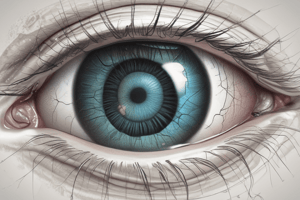Podcast
Questions and Answers
Which part of the cornea will assist greatly in the renewal of a corneal abrasion?
Which part of the cornea will assist greatly in the renewal of a corneal abrasion?
- External stratified squamous epithelium (correct)
- Inner simple squamous epithelium
- Descemet's membrane
- Stroma
What type of cartilage is found in the auricle?
What type of cartilage is found in the auricle?
- Elastic (correct)
- Hyaline
- Cartilaginous
- Fibrous
Which structure is NOT an effector organ/structure?
Which structure is NOT an effector organ/structure?
- Skeletal muscle
- Eyeball (correct)
- Epidermis skin
- Gastric glands
In the auditory pathway, what structure is involved in N3?
In the auditory pathway, what structure is involved in N3?
Which layer of skin is composed of loose connective tissue?
Which layer of skin is composed of loose connective tissue?
What is the correct order of the layers of the skin?
What is the correct order of the layers of the skin?
Which of the following is NOT a function of the muscular system?
Which of the following is NOT a function of the muscular system?
Which Brodmann's area is responsible for primary visual cortex?
Which Brodmann's area is responsible for primary visual cortex?
What is the optic radiation also known as?
What is the optic radiation also known as?
At which level of the brain does the developing ear arise?
At which level of the brain does the developing ear arise?
What is the source of the developing eye?
What is the source of the developing eye?
What is the function of the tectorial membrane?
What is the function of the tectorial membrane?
Which of the following is NOT a pointed structure?
Which of the following is NOT a pointed structure?
What is the function of the encircled structure in the eye?
What is the function of the encircled structure in the eye?
What is the destination of the optic radiation?
What is the destination of the optic radiation?
Which of the following is a type of sensory receptor?
Which of the following is a type of sensory receptor?
Which sinus is located in the inferior part of the falx cerebri?
Which sinus is located in the inferior part of the falx cerebri?
What is the characteristic of a neuromuscular spindle?
What is the characteristic of a neuromuscular spindle?
In which direction do the nasal fibers decussate in the optic chiasm?
In which direction do the nasal fibers decussate in the optic chiasm?
Which type of receptor is non-capsulated?
Which type of receptor is non-capsulated?
Which side of the body is affected by a cerebellar lesion?
Which side of the body is affected by a cerebellar lesion?
Which sensation has a slow adaptability?
Which sensation has a slow adaptability?
Which of the following is not a type of mechanoreceptor?
Which of the following is not a type of mechanoreceptor?
Which part of the falx cerebri contains the superior sagittal sinus?
Which part of the falx cerebri contains the superior sagittal sinus?
Flashcards are hidden until you start studying
Study Notes
Optic Radiation and Eye Development
- The optic radiations are also known as the Geniculo-calcarine tract.
- The developing ear arises at the level of the rhombencephalon.
- The development of the eye is derived from surface ectoderm, neural crest cells, and neuroectoderm.
Anatomy of the Eye
- The tectorial membrane is a pointed structure.
- The Meissner's corpuscle is a pointed structure.
- The external stratified squamous epithelium layer of the cornea assists in the renewal of corneal abrasion.
Auditory Pathway
- N3 of the auditory pathway involves the Ipsilateral and contralateral trapezoid body + Superior olivary nucleus.
Cartilage and Skin
- The auricle contains elastic cartilage.
- The dermis is the layer of skin that is beneath the epidermis.
Neuroanatomy
- The gastric glands are effector organs/structures.
- The primary visual cortex is not Brodmann's area of the inferior sagittal sinus.
- Neuromuscular spindles are encapsulated.
- The anterior part of the cerebellum is affected in cerebellar lesions, causing deficits on the same side as the lesion.
Receptors
- Hair follicle receptors are non-capsulated.
- Pacinian corpuscles and Ruffini corpuscles are encapsulated receptors.
Studying That Suits You
Use AI to generate personalized quizzes and flashcards to suit your learning preferences.





